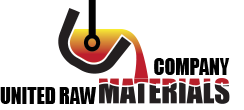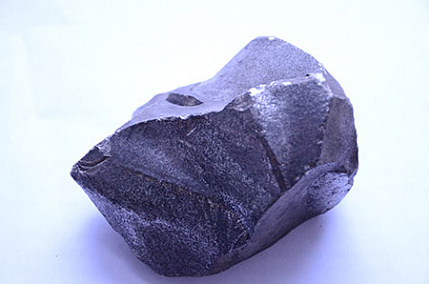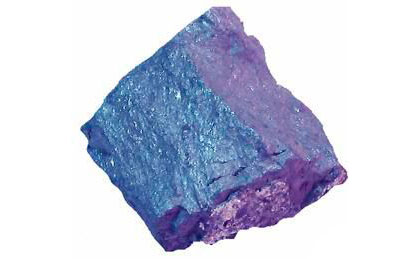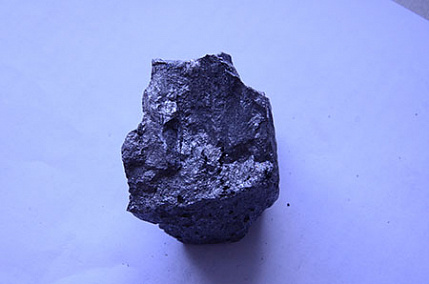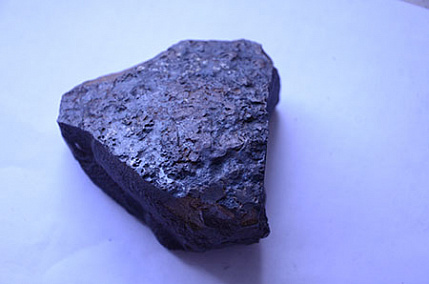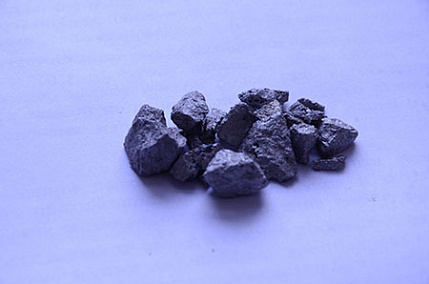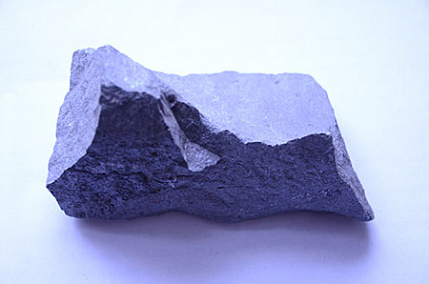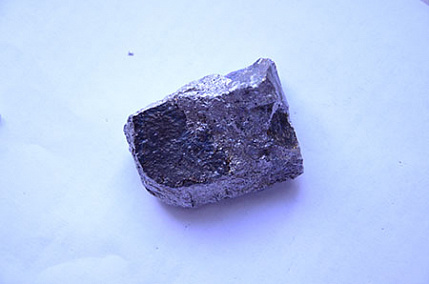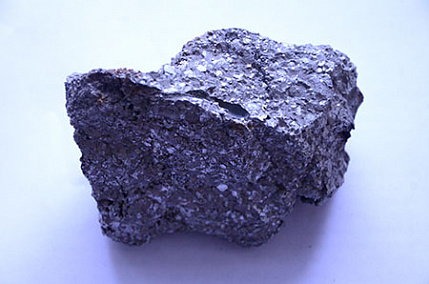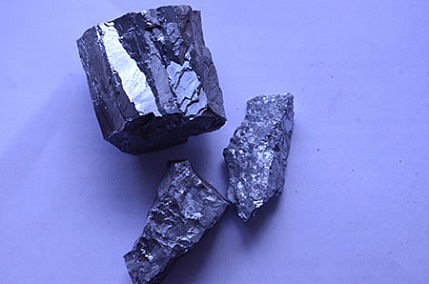Ferroalloys
Ferroalloys
� Ferroalloys are iron alloys with other elements (Cr, Si, Mn, Ti, etc.) used mainly for deoxidation and alloying steel (e. g., ferrochromium, ferrosilicon). Some alloys containing iron only in the form of impurities (silicocalcium, silicomanganese, etc.) and some metals and nonmetals (Mn, Cr, Si) with a minimum content of impurities are also classified as ferroalloys. They are produced from ores or concentrates in electric furnaces or smelting shafts (hearths). Typically, the cost of any metal in the form of a ferroalloy is lower than its cost in the pure state. More specifically, this occurs due to the fact that ore usually contains iron in one form or another, and during the ore processing, iron goes to the alloy together with the main component, whereupon the flow chart of the ferroalloy production is found to be one of the shortest and cheapest ways of raw material processing. At the same time, additional technological steps that complicate the process and increase its costs are necessary to produce the refined alloy. Thus, manufacture of iron-containing metal can be either completely excluded or be one of the intermediate stages, when a conversion ferroalloy is processed into refined metal. Iron dissolves the main element, reduces its activity and lowers the melting range of the alloy in the course of the reduction melting. The use of an alloying element in the form of a ferroalloy increases the recovery rate and reduces melting loss during alloying and deoxidation of steel and alloys.
Ferroalloy production
Ferroalloy industry, production of ferroalloys at the specialized plants in the ferrous metal sector. The most common method of ferroalloys production is the electrothermic method (electric-furnace method) of electroferroalloys production. Depending on the used reducing agent, this method is subdivided into the carbothermic method for producing carbon ferroalloys (5�8 % C) and all silicon alloys, and metallothermic method (also conventionally including the silicothermic method) for producing low-carbon alloys (0,01-2,5 % C). Ferrosilicon, crystalline silicon, silicoaluminium, silicocalcium, ferrosilicocalcium, silicomanganese, silicochromium, carbon ferromanganese and ferrochromium, ferrophosphorus, complex silicon-based alloys as well as low-phosphorus manganese slag are produced by the carbothermic method (carbothermy) mainly in the submerged-arc furnaces with a capacity of 16.5-72 MVA. Production of blast furnace ferroalloys (low-grade ferrosilicon and ferromanganese) is very small and gradually declining, since they are more contaminated and more expensive than electroferroalloys.
Low-carbon (refined) ferroalloys are produced by the metallothermic method (metallothermy) in electric arc (refining) furnaces with power 2.5-5.5 MVA. The silicothermic method (silicothermy) is used to produce low and extra low-carbon alloys of manganese and chromium, ferrovanadium (aluminium is also added to the charge), ferrotungsten (breeze coke is added to the charge) and silicozirconium. The aluminothermic method (aluminothermy) is suitable to produce metal chromium, extra low-carbon ferrochromium, ferroniobium, ferroboron, silicozirconium and various master alloys with rare and rare-earth metals. Medium-carbon ferrochromium is produced from carbon ferrochromium in oxygen converters. Electric resistance and induction furnaces are used to manufacture nitrogen-bearing (nitrided) alloys of manganese, chromium and vanadium. Ferrotitanium, metallic chromium and vanadium are produced by the aluminothermic method in smelting crucibles, while ferromolybdenum is produced there by the silicothermic method (aluminium is also added to the charge).
The so-called "bulk" and "non-bulk" ferroalloys are differentiated by their production volumes.
Bulk ferroalloys:
- silicon ferroalloys
- manganese ferroalloys
- chromium ferroalloys.
Non-bulk ferroalloys:
- ferrotungsten
- ferromolybdenum
- ferrovanadium
- alkaline-earth metal alloys
- ferroniobium
- ferrotitanium and titanium-containing alloys
- ferroboron, ferroboral and boron-containing master alloys
- aluminium alloys
- rare-earth metal alloys
- ferrosilicozirconium, ferroaluminozirconium
- ferronickel and ferrocobalt
Silicon ferroalloys
In D. I. Mendeleev�s periodic table of chemical elements, silicon is in p-block, group 4, period 3 and has atomic number 14 and symbol Si (derived from the Latin word silicium).
Production
In the industry, metallurgical grade silicon is produced by reducing SiO2 melt with coke in the submerged-arc furnaces of the shaft type at a temperature of about 1,800 �C. The purity level of such silicon can reach 99.9 % (main impurities are carbon and metals). This silicon product may be further refined to remove impurities.
Pure silicon can be obtained under laboratory conditions by preliminary synthesis of magnesium silicide Mg2Si. Gaseous monosilane SiH4 is then produced by treating magnesium silicide with hydrochloric or acetic acid. Monosilane is purified by rectification, sorption or other methods and subsequently decomposed into silicon and hydrogen at a temperature of about 1,000 � C.
Silicon purification on an industrial scale is carried out by direct chlorination of silicon. SiCl4 and SiCl3H compounds are formed in this case. These chlorides are refined to remove impurities by various methods (usually by distillation and disproportionation) and reduced with pure hydrogen at the final stage at temperatures 900� 1,100 �C. Cheaper, more environmentally compliant and efficient industrial methods of silicon purification are being developed. In 2010, the following methods can be reckoned among the above mentioned ones: silicon purification technology using fluorine (instead of chlorine); distillation of silicon monoxide; technologies based on etching impurities that concentrate at the intercrystalline boundaries. Impurities content in final purified silicon can be reduced to 10-8�10-6 % by weight. Production of ultra-pure silicon is discussed in greater detail in the academic paper Polycrystalline silicon. A process to produce pure silicon was developed by Nikolay Nikolayevich Beketov. In Russia, metallurgical grade silicon is produced by UC Rusal at its facilities in the cities of Kamensk-Uralsky (Sverdlovsk region) and Shelekhov (Irkutsk region); final silicon purified by the chloride method is produced by Nitol Solar group at its production complex in the town of Usolye-Sibirskoye.
Application
Metallurgical grade silicon has the following applications:
- raw material for metal sector: a component of alloys (bronzes, silumins); reducing agent (for iron production); modifier or alloying element (e. g., addition of a certain amount of silicon during production of grain-oriented steel increases the coercive force of the final product), etc.;
- raw material for the production of purer polycrystalline silicon and purified metallurgical silicon (so called umg-Si);
- raw material for the production of organosilicon materials, silanes;
- sometimes metallurgical grade silicon and its alloy with iron (ferrosilicon) are used to produce hydrogen in the field.
Ultra-pure silicon is mainly used for the production of discrete circuits (non-linear passive components of electrical circuits) and monolithic integrated circuits. Pure silicon, ultra-pure silicon waste and purified metallurgical silicon in the form of crystalline silicon are main raw materials for photovoltaics. In addition to electronics and solar energy technologies, monocrystalline silicon is used to make mirrors of gas lasers. Metallic silicides, compounds of metals with silicon, are materials with a wide range of useful chemical, electrical and nuclear properties (resistance to oxidation, neutron irradiation, etc.) widely used in industry (for example, in the electronic and nuclear branches). Silicides of several elements are important thermoelectric materials. Silicon compounds are the basis for the production of glass and cement. Silicate industry embraces the production of glass and cement. This sector also produces silicate ceramics � brick, porcelain, earthenware and pottery. Widely known sodium silicate is used as a siccative in construction and as paper glue in pyrotechnics and in everyday life. Silicone oils and silicones, organosilicon-based materials, are accepted as good practice.
Manganese ferroalloys
In D. I. Mendeleev�s periodic table of chemical elements, manganese is in d-block, group 7, period 4 and has atomic number 25. Its symbol is Mn (derived from the Latin word manganum and read in chemical formulas as [em-en], for example, KMnO4 � [kay-em-en-o-four] or [potassium permanganate]). Manganese in its elementary form (CAS number 7439-96-5) is silvery-white. There are five allotropic modifications of manganese - four with cubic crystal lattice and one with tetragonal crystal lattice.
Occurrence
Manganese is the 14th most abundant element on the Earth and, after iron, the second of heavy metals in the Earth's crust (0.03 % of the total number of atoms in the Earth's crust). Manganese content increases from acid (600 g/t) to basic rocks (2.2 kg/t). Manganese accompanies iron in many iron ores, but there are also specifical manganese deposits. 40 % of manganese ores are concentrated in the Chiatura field (near Kutaisi). Manganese scattered in the rocks is washed with water and carried to the World Ocean. Upon that, manganese content in the sea water is minute (10 7�10 6 %), while its concentration increases up to 0.3 % in the deepest parts of the ocean due to its oxidation by the dissolved oxygen and formation of a water-insoluble manganese oxide that descends to lower layers of the ocean in the hydrated form (MnO2�xH2O) and creates the so-called ferromanganese nodules on the bottom, in which the amount of manganese can reach 45 % (the nodules also contain admixtures of copper, nickel and cobalt). These nodules could be a source of manganese for the industry in the future. In Russia, manganese raw materials are in very short supply, the following deposits are known: Usinskoe in Kemerovo Region, Polunochnoye in Sverdlovsk Region, Porozhinskoe in Krasnoyarsk Region, South Khingan in the Jewish Autonomous Region, Rogachevo-Taininskaya block and Severo-Taininskoe field on the Novaya Zemlya.
Production methods
- Aluminothermic method to reduce Mn2O3 oxide obtained by roasting of pyrolusite 4MnO2 → 2Mn2O3 + O2; Mn2O3 + 2Al → 2Mn + Al2O3
- Reduction of iron-bearing oxide manganese ores with coke. Ferromanganese (containing ≅80 % Mn) is usually produced by this method in metal sector.
- Electrolysis for production pure metallic manganese.
Application
Ferromanganese is used for deoxidation in steelmaking, that is for removal of oxygen from steel. In addition, manganese binds sulfur, which also improves steel properties. Addition of 12-13 % Mn to steel, sometimes in combination with other alloying metals, strongly strengthens steel making it hard and resistant to wear and shock (the so-called Hadfield steel becomes notably stronger and harder under impacts). This steel is used in the manufacture of mill balls, excavation and stone crushing machines, armoured elements, etc. Up to 20 % Mn is added to spiegeleisen. The alloy containing 83 % Cu, 13 % Mn and 4 % Ni (manganin) has a high electrical resistance that varies only slightly with temperature. For this reason, it is used for the manufacture of rheostats, etc. Manganese is also added to bronzes and brasses.
Significant amount of manganese dioxide is consumed in the production of manganese-zinc galvanic cells, MnO2 being used in such elements as an oxidant-depolarizer. Manganese compounds are also widely used both in the specialty organic synthesis (MnO2 and KMnO4 as oxidizing agents) and in the industrial organic synthesis (as hydrocarbon oxidation catalyst components, for example, in the production of terephthalic acid by oxidation of p xylene or in oxidation of paraffins to higher fatty acids). Prices for 95%-pure metallic manganese in ingots were on average 2.5 USD/kg in 2006. Giant magnetocaloric effect amplified by pressure is observed in manganese arsenide. Manganese telluride is a promising thermoelectric material (it generates thermoelectromotive force 500 �V/K).
Chromium alloys
In D. I. Mendeleev�s periodic table of chemical elements, chromium is in d-block, group 6, period 4 and has atomic number 24. Its symbol is Cr (derived from the Latin word chromium). Chromium in its elementary form (CAS number 7440-47-3) is a solid bluish-white metal.
Occurrence
Chromium is an abundant element (0.02 % wt.). The main chromium mineral is chrome ironstone (chromite) FeO�Cr2O3. The second most important mineral is crocoite PbCrO4.
Production
Chromium occurs in nature mainly in the form of chrome ironstone Fe(CrO2)2 (iron chromite). Ferrochromium is produced from it by reduction with coke (carbon) in electric furnaces: FeO�Cr2O3 + 4C → Fe + 2Cr + 4CO ↑. Ferrochrome is used for the production of alloyed steels.
Pure chromium is produced by the following reactions:
- iron chromite is fused with sodium carbonate (soda ash) in air: 4Fe (CrO2)2 + 8Na2CO3 + 7O2 → 8Na2CrO4 + 2Fe2O3 + 8CO2 ↑;
- sodium chromate is dissolved and separated from iron oxide;
- chromate is converted to dichromate by acidifying solution and isolating dichromate by crystallization;
- pure chromium oxide is produced by reduction of dichromate with coal: Na2Cr2O7 + 2C → Cr2O3 + Na2CO3 + CO ↑;
- metallic chromium is produced by aluminothermy: Cr2O3 + 2Al → Al2O3 + 2Cr + 130 kcal;
- electrolytic chromium is produced by electrolysis of a solution of chromic anhydride in water containing sulfuric acid. In this case, the following 3 processes predominantly occur at the cathode: reduction of hexavalent chromium to trivalent chromium that passes into solution; discharge of hydrogen ions to give gaseous hydrogen; discharge of ions containing hexavalent chromium and deposition of metallic chromium: Cr2O72-+ 14H+ + 12e- = 2Cr + 7H2O.
Application
Chromium is an essential component of many alloyed steels (including stainless steels), as well as other alloys. It is used in wear-resistant and decorative coatings (chromium plating). Chromium is used in chromium-30 and chromium-90 alloys indispensable for nozzles of high-power plasma torches and in the aerospace industry.
Ferrotungsten
Ferrotungsten is an iron-tungsten alloy (ferroalloy) used for alloying steel and alloys in the ferrous metallurgy. Raw materials. Main minable tungsten minerals include ferberite FeWO4, hübnerite MnWO4, wolframite (Fe,Mn)WO4 and scheelite CaWO4. Tungsten ores typically contain 0.2-0.5 % WO3, minerals of molybdenum, tin, copper, arsenic and other elements are also present there. These ores are processed by various gravitational methods: jigging, table and strake concentration. The final concentrates typically contain 55-65 % WO3. High-iron ores can be further processed in magnetic separators; flotation and electrostatic separation are used to separate scheelite and sulphides and upgrade metal content. Scheelite ores are processed by flotation in fatty acids (oleic acid, sodium oleate and liquid soap), pine oil or creosol being used as a frothing agent.
Application
Ferrotungsten is used in ferrous metallurgy for alloying steel and alloys. Tungsten is a component of high-speed, high-temperature, magnetic and some structural steels, it increases tensile strength and yield strength of steel, its strength and hardness at higher temperatures, increases intensity of magnetization and improves coercive properties of magnetic steels.
Ferromolybdenum
Ferromolybdenum is a ferroalloy containing 50 60 % molybdenum.
Application
Ferromolybdenum is used instead of pure molybdenum for alloying steel, cast iron and alloys. Thus, molybdenum content in steels varies from 0.1-0.3 % in the alloyed grades to 3-10 % in the tool grades. Molybdenum improves surface and depth hardenability of steels, increases their toughness, neutralizes temper brittleness of nickel-chromium steels and helps to preserve steel properties at higher temperatures. Molybdenum added to cast iron increases its strength and wear resistance.
Application
Source materials
Raw materials for the production of ferromolybdenum include quartz-molybdenite, copper-molybdenum and molybdenum-tungsten ores in which the major molybdenum mineral is molybdenite MoS2. Such raw materials are mainly processed by flotation. As a result, molybdenum concentrates containing up to 35 % sulfur, both in molybdenum sulphide MoS2 and in sulphides of other elements - copper, iron, etc., are produced.
Ferrovanadium
Ferrovanadium is a ferroalloy containing 35 45 % V, 1-3 % Si, 0.5-1.5 % Al (Fe and impurities - balance).
Application
Ferrovanadium is used in ferrous metallurgy for alloying steels, alloys and cast iron to obtain fine-grained structure, increase toughness and steel resistance to alternating loads as well as improve hardenability. Nitrogen-bearing ferrovanadium used for alloying high-speed, low-alloyed, stainless and cold-resistant steels with vanadium and nitrogen. Ferrovanadium is delivered in steel drums in lumps weighing 5-15 kg.
Alkaline-earth metal alloys
Alkaline-earth metals � beryllium, magnesium, calcium, strontium, barium and radium � are the chemical elements of group 2 in the periodic table. They are so named because their oxides � earths (in the terminology of the alchemists) � give alkaline properties to water. Salts of alkaline-earth metals, except for radium, are common in nature in the form of minerals.
Alkaline-earth metals have the electronic configuration of the outer energy level ns² and, along with the alkali metals, are s-elements. Alkaline-earth metals easily lose two valence electrons and have an oxidation state +2 (rarely +1) in all their compounds. The chemical activity of alkaline-earth metals increases with increasing atomic number. Beryllium in its compact form does not react with oxygen or halogens even at red heat (up to 600 �C); a much higher temperature is required for the reaction with oxygen and other chalcogens, fluorine being an exception. Magnesium has a protective oxide film at room and higher temperatures (up to 650 �C) and does not oxidize further. Calcium is slowly oxidized depthward at room temperature (in the presence of water vapour); it burns in oxygen in the preheated state, but is stable in dry air at room temperature. Strontium, barium and radium are rapidly oxidized in air to give a mixture of oxides and nitrides, so they, like alkali metals and calcium, are kept under a layer of kerosene. Oxides and hydroxides of alkaline-earth metals tends to increase their basic properties with the growth of atomic number: Be(OH)2 is an amphoteric hydroxide insoluble in water, but soluble in acids (it also demonstrates acidic properties in the presence of strong bases); Mg(OH)2 is a weak base insoluble in water; Ca(OH)2 is a strong base slightly soluble in water; Sr(OH)2 is more soluble in water than calcium hydroxide; it is a strong base (alkali) at high temperatures close to the boiling point of water (100 �C); Ba(OH)2 is a strong base (alkali), which is comparable in strength to KOH or NaOH; Ra(OH)2 is one of the strongest bases and a very corrosive substance.
Occurrence
All alkaline-earth metals are present in nature in varying quantities. All of these metals do not occur in the free state due to their high chemical activity. The most common alkaline-earth metal is calcium, the amount of which is equal to 3.38 % (of the Earth's crust by weight). It is a little inferior to magnesium, the amount of which is equal to 2.35 % (of the Earth's crust by weight). Barium and strontium are also abundant in nature, they constitute 0.05 and 0.034 % wt. of the Earth's crust respectively. Beryllium is a rare element, it constitutes 6�10-4 % wt. of the Earth's crust. Radioactive radium is the rarest of all the alkaline-earth metals, but it is always present in uranium ores in small amounts. In particular, it can be recovered by chemical methods. It constitutes 1�10-10 % wt. (of the Earth's crust).
Ferroniobium
Ferroniobium is a ferroalloy containing about 60 % Nb (or Nb + Ta), 10-12.5 % Si, 2-6 % Al and 3 8 % Ti (Fe and impurities are the balance); it is produced by the electric-furnace aluminothermic method from pyrochlore concentrate or technical niobium pentoxide. Niobium is used for producing structural steel and superalloys.
Ferrotitanium and titanium-containing alloys
Ferrotitanium is a ferroalloy containing up to 35 or more than 60 % Ti, 1-7 % Al, 1-4.5 % Si, up to 3 % Cu (Fe and impurities are the balance).
Production
Ferrotitanium is produced by the aluminothermic method in smelting crucibles from ilmenite concentrate and titanium scrap (low-grade ferrotitanium) or by melting iron and titanium scrap in an electric furnace (high-grade ferrotitanium).
Application
Ferrotitanium is used for deoxidation and alloying steel.
In D. I. Mendeleev�s periodic table of chemical elements, titanium (derived from the Latin word titanium, symbol Ti) is in d-block, group 4, period 4 and has atomic number 22. Titanium in its elementary form (CAS number 7440-32-6) is a light silvery-white metal. This metal has two crystal modifications: α-Ti has hexagonal close-packed lattice, β-Ti has body-centered cubic lattice, the temperature of the polymorphic transformation α↔β is 883 �C. The melting point of titanium is 1,660�20 �C.
Occurrence
Titanium ranks 10th among the abundant elements in nature. It constitutes 0.57 % wt. in the Earth's crust, and its concentration in sea water is 0.001 mg/l, in ultramafic rocks 300 g/t, in basic rocks 9 kg/t, in basic rocks 2.3 kg/t, in clays and shales 4.5 kg/t. In the earth's crust, titanium is nearly always tetravalent and is present only in the oxygen compounds. Titanium does not occur in a free state. Titan has geochemical affinity with Al2O3 under conditions of weathering and sedimentation. He concentrates in bauxites of the crust of weathering and in marine clay sediments. Titanium is transported in the form of mechanical mineral debris and in the form of colloids. Some clays accumulate up to 30 % wt. TiO2. Titanium minerals are resistant to weathering and form large concentrated placers. More than 100 titanium-containing minerals are known. The most important minerals include rutile TiO2, ilmenite FeTiO3, titanomagnetite FeTiO3+Fe3O4, perovskite CaTiO3 and titanite CaTiSiO5. Ledge titanium ores (ilmenite-titanomagnetites) and placer titanium ores (rutile-ilmenite-zircon) are differentiated.
A monument to Gagarin on Leninsky Avenue in Moscow is made of titanium.
This metal is used in chemical industry (reactors, piping, pumps, valves and fittings), military engineering (body armour, aviation armour, submarine hulls), industrial technology (desalination, processing pulp and paper), in automotive, agricultural and food sectors, piercing jewellery, medical industry (prostheses, osteal prostheses), dental and endodontic instruments, dental implants, sporting goods, jewellery (Alexander Khomov), mobile phones, light alloys, etc. Titanium is the most important structural material in aircraft, rocket and shipbuilding. Titanium is cast in vacuum furnaces into graphite moulds. The vacuum investment casting is also used. Titanium finds a limited application in the art casting due to technological difficulties. The monument to Yuri Gagarin on the square named after him in Moscow is the first in the world monumental sculpture cast in titanium.
Titanium is an alloying additive to many stainless steels and many special alloys.
Nitinol (nickel-titanium) is an alloy with shape memory used in medicine and industry.
Titanium aluminides are highly resistant to oxidation and heat, which determines their use as construction materials in the aviation and automotive industries.
Compounds
White titanium dioxide (TiO2) is used in paints (such as titanium white) and for the manufacture of paper and plastic. It is a food additive E171. Organotitanium compounds (e. g. tetrabutoxytitanium) are used as catalysts and hardeners in the chemical and paint industries. Inorganic titanium compounds are used as additives or coatings in the chemical, electronic and fiber-glass industries. Titanium carbide, titanium diboride and titanium carbonitride are important components of superhard materials for metal working. Titanium nitride is applied for coating tools and manufacturing costume jewellery, as it resembles gold in colour. Barium titanate BaTiO3, lead titanate PbTiO3 and some other titanates are ferroelectrics. There are many titanium alloys with various metals. Alloying elements are subdivided into three groups depending on their influence on the temperature of the polymorphic transformation: beta stabilizers, alpha stabilizers and neutral elements. The first group lowers the beta transus temperature, the second group increases the above temperature and the third group does not affect it, but lead to solid solution hardening of the matrix. Examples of alpha-stabilizers include aluminium, oxygen, carbon and nitrogen. Beta stabilizers include molybdenum, vanadium, iron, chromium and nickel. Zirconium, tin and silicon are neutral elements. Beta stabilizers are further classified into two groups: beta isomorphous and beta eutectoid. The most common titanium alloy is the alloy Ti-6Al-4V (BT6 in Russian classification).
Ferroboron, ferroboral and boron-containing master alloys
In D. I. Mendeleev�s periodic table of chemical elements, boron is in p-block, group 3, period 2 and has atomic number 5. Its symbol is B (derived from the Latin word borum). Boron in its elementary form is a colourless, grey or red crystalline material or dark amorphous material. More than 10 allotropic modifications of boron are known, their formation and mutual transitions being determined by the temperature at which the boron was obtained.
Occurrence
The average content of boron in the Earth's crust is 4 g/t. Despite this, there are about 100 boron minerals, and this element almost never occurs in foreign minerals. This is due primarily to the fact that the complex anions of boron (it is present in this form in most of the minerals) do not have common analogues. Boron is bound with oxygen in almost all the minerals, and the group of fluorine compounds is quite small. Elemental boron is not found in nature. It is present in many compounds and occurs widely, especially in small concentrations. Boron is found in many igneous and sedimentary rocks in the form of borosilicates and borate as well as an isomorphous admixture in minerals. Boron is known in oil and sea water (its concentration in sea water is 4.6 mg/l), in waters of salt lakes, hot springs and mud volcanoes.
Application
Elemental boron
Boron (as fibers) is a reinforcing agent in many composite materials. Boron is also often used in electronics to change the conductivity of silicon. Boron is used in metallurgy as a microalloying element that greatly increases hardenability of steels. Boron is used in medicine for boron neutron capture therapy (a method of selective destruction of malignant tumor cells).
Boron compounds
Compact boron carbide is used for the manufacture of gasodynamic bearings. Perborate / peroxoborates (with [B2(O2)2(OH)4]2- ions) are technical products containing up to 10.4 % active oxygen; they are major components of chlorine-free bleachers (persil, persol, etc.). It is worth to point out that boron-carbon-silicon compounds have superhigh hardness, and their microhardness is comparable to that of any abrasives except diamond and boron nitride; boron-carbon-silicon compounds exceed all known abrasives by their cost and economic efficiency of grinding.
For the moment, a boron-magnesium alloy (magnesium diboride MgB2) has a record high critical temperature of the superconducting transition among the type-I superconductors. The above report has stimulated a significant increase in research intensity in this field. In the nuclear power industry, boric acid (H3BO3) is widely used as a neutron absorber of thermal (slow) neutrons in PWR (VVER) nuclear reactors. Due to its neutron-physical characteristics and capability to dissolve in water, boric acid enables smooth (not discontinuous) variation of a nuclear reactor power by changing its concentration in the coolant (the so-called boron control). Carbon-activated boron nitride is a material that luminesces blue to yellow when exposed to UV light, has an independent phosphorescence in the dark and is activated by organic substances when heated to 1,000 �C. Manufacture of BN/C boron nitride luminescence materials has no industrial use, but was a general practice of amateurs in the first half of the twentieth century.
Boron hydrides and organoboron compounds
A number of boron derivatives (boron hydrides) are extremely effective rocket propellant (diborane B2H6, pentaborane, tetraboran, etc.), and some polymeric compounds with hydrogen and carbon are extremely resistant to chemicals and high temperatures (like the well-known plastic carborane-22).
Borazon and its hexahydride
Electron configuration of boron nitride (borazon) is similar to that of carbon. A large group of organic-like compounds can be obtained on its basis. Thus, borazon hexahydride (H3BNH3), similar to ethane by its structure, is a solid compound with a density of 0.78 g/cm3 under normal conditions that contains about 20 % wt. hydrogen. It can be used in hydrogen fuel cells to supply electricity for electric cars.
Aluminium alloys
In D. I. Mendeleev�s periodic table of chemical elements, aluminium is in p-block, group 3, period 3 and has atomic number 13. Its symbol is Al (derived from the Latin word aluminium). It is included into the group of light metals. Aluminium is the most common metal and the third most abundant chemical element in the Earth's crust (after oxygen and silicon). Aluminium in its elementary form (CAS number 7429-90-5) is a light silvery-white paramagnetic metal easily processed by forming, casting and machining. Aluminium has high thermal and electrical conductivity, corrosion resistance due to the rapid formation of stable oxide films that protect the surface from further interaction.
Production
The modern method of aluminium production was developed independently by an American, Charles Hall, and Frenchman, Paul Héroult, in 1886. It comprises dissolution of aluminium oxide Al2O3 in molten cryolite Na3AlF6 followed by the electrolysis using consumable coke or graphite electrodes. This production method consumes a lot of electricity and was in demand only in the twentieth century. The production of 1,000 kg of crude aluminium requires 1920 kg of alumina, 65 kg of cryolite, 35 kg of aluminium fluoride, 600 kg of anode paste and 17,000 kW�h of DC electricity.
Application
One-piece aluminium parts are widely used as a construction material with the following main advantages: lightness, formability, corrosion resistance (in air, aluminium is instantly covered with Al2O3 solid film that prevents metal from further oxidation), high thermal conductivity, non- toxicity of its compounds. In particular, these properties have made aluminium extremely popular in the manufacture of kitchen utensils and aluminium foil for food and packaging. The main disadvantage of aluminium as a construction material is a low strength value, so it is usually alloyed with small amounts of copper and magnesium to obtain duralumin alloy. Electrical conductivity of aluminium is 1.7 times less than that of copper, aluminium being about 4 times cheaper, but, due to 3.3 times lower density, aluminium quantity required to obtain equal strength is about 2 times less. Therefore, it is widely used in electrical engineering to produce wires and cable screens and even conductors in chips in microelectronics. Lower conductivity of aluminium (37 Ohm-1) as compared to copper (63 Ohm-1) is compensated by an increase of cross-sections of aluminium conductors. A disadvantage of aluminium as an electrical material is a solid oxide film which hinders soldering. Due to the complex of its properties, aluminium is widely used in the thermal equipment.
Aluminium and its alloys preserve strength at extremely low temperatures. As a result, this metal is widely used in cryogenics. High reflection coefficient combined with low cost and ease of coating makes aluminium an ideal material for the manufacture of mirrors. Aluminium is used as a gas-generating agent in the production of building materials. Aluminizing makes steel and other alloys resistant to corrosion and scaling, for example, in valves of reciprocating internal combustion engines, turbine blades, oil platforms, heat-exchanging units, as well as replaces galvanizing. Aluminium sulfide is used for the production of hydrogen sulfide. Foam aluminium, a particularly strong and light material, is now developed.
Rolled aluminium products
Aluminium-magnesium alloys Al-Mg (5xxx series). Al-Mg alloys are characterized by a combination of satisfactory strength, good ductility, very good weldability and corrosion resistance. In addition, these alloys have high vibration resistance. Al3Mg2 compound and aluminium-based solid solution form a eutectic system in the alloys of this system with Mg content up to 6%. Alloys with 1 to 5 % magnesium are the most widely used in industry. Increase of Mg content in the alloys significantly increases their strength. Each percentage point of magnesium content increases the tensile strength of the alloys by 30 MPa and the yield strength by 20 MPa. In this case, elongation decreases slightly and ranges within 30 to 35 %.
Alloys that contain up to 3 % magnesium (by weight) are structurally stable at room and elevated temperatures, even in a heavily work-hardened state. As magnesium concentration rises, the structure of the work-hardened alloy becomes unstable. Moreover, magnesium content exceeding 6 % results in a deterioration of the corrosion resistance of the alloy. To improve strength properties of Al-Mg alloys, they are alloyed with chromium, manganese, titanium, silicon and vanadium. It is advisable to avoid copper and iron present in the alloys of this system, because the elements reduce corrosion resistance and weldability of the alloys. Aluminium-manganese alloys Al-Mn (3xxx series). The alloys of this system have good strength, ductility and workability, as well as high corrosion resistance and good weldability.
The main impurities in Al-Mn alloys are iron and silicon. Both of these elements reduce solubility of manganese in aluminium. Alloys of this system are alloyed with titanium to obtain a fine-grained structure. Sufficient amounts of manganese ensure stable structure of work-hardened metal at room and elevated temperatures.
Aluminium-copper alloys Al-Cu (Al-Cu-Mg) (2xxx series). Mechanical properties of the QTB-treated alloys of this system come to or sometimes exceed those of low carbon steels. These alloys are easily deformable and machined. However, they have a disadvantageously low corrosion resistance, which makes it necessary to use protective coatings. Manganese, silicon, iron and magnesium can be used as alloying elements. And the latter has the most powerful influence on the properties of alloys: magnesium significantly increases the tensile strength and yield strength values. The addition of silicon to the alloys increases their ability for artificial aging. Alloying with iron and nickel increases high-temperature strength of the second series alloys. Work hardening of the alloys after their quenching accelerates artificial aging and improves strength and stress corrosion resistance.
Al-Zn-Mg (Al-Zn-Mg-Cu) alloys (7xxx series). Alloys of this system are valued for very high strength and good processability. Alloy 7075, a representative of this system, has the maximum strength among aluminium alloys. High strengthening is achieved due to the fact that high solubility of zinc (70 %) and magnesium (17.4 %) at elevated temperatures drastically reduces on cooling. However, a significant disadvantage of these alloys is a very low stress corrosion resistance. Copper alloying allows to improve stress corrosion resistance of alloys.
The following regularity discovered in 1960s should not be left unmentioned: lithium present in alloys slows down the natural aging and accelerates the artificial aging. In addition, lithium reduces specific gravity of alloy and significantly increases its modulus of elasticity. Al-Mg-Li, Al-Cu-Li and Al-Mg-Cu-Li new alloy systems have been developed on the basis of this discovery. Aluminium-silicon alloys (silumins) are best suited for casting. Housings of different mechanisms are often cast of these alloys.
Aluminium as an additive to other alloys
Aluminium is an important component of many alloys. For example, aluminium and copper are the main components of aluminium bronzes. The most commonly used additive in magnesium alloys is aluminium. Fechral (Fe, Cr, Al) and other alloys are used to produce electric heater coils.
Jewellery
Different types of jewellery were made of aluminium when it was very expensive. Thus, Napoleon III ordered the aluminium buttons, and the scales with bowls of gold and aluminium were given to Mendeleev in 1889. The fashion for aluminium went out as soon as new production methods were invented to cut cost by times. Nowadays aluminium has a limited application in the manufacture of costume jewellery. In Japan, aluminium is used in lieu of silver to produce traditional adornments.
Glass production
Aluminium fluoride, phosphate and oxide are used to produce glass.
Food industry
Aluminium is registered as a food additive E173.
Aluminium and its compounds in rocket engineering
Aluminium and its compounds are used as a high-performance comburent in bipropellants and as a combustible component in solid rocket fuels. The following compounds of aluminium are of greatest practical interest when used as a rocket fuel. Aluminium powder is a comburent in solid rocket fuels. This metal can also be used as a powder or suspensions in hydrocarbons.
- Aluminium hydride
- Aluminium boranate
- Trimethylaluminium
- Triethylaluminium
- Tripropylaluminium
Rare-earth metal alloys
Rare-earth group consists of 17 elements, including lanthanum, scandium, yttrium and the lanthanides. All of these elements are silver-white metals having similar chemical properties (the most typical oxidation state is +3).
Occurrence
As a rule, rare-earth elements are found in nature together. They form a very stable oxides, halides and sulfides. Compounds of trivalent elements are the most typical for lanthanides. The exception is cerium which easily becomes tetravalent. Besides cerium, praseodymium and terbium form tetravalent compounds. Divalent compounds are known for samarium, europium, and ytterbium. Physical and chemical properties of lanthanides are very similar. It is explained by a peculiar structure of their electron shells. The total content of rare-earth elements exceeds 100 g/t. There are more than 250 minerals containing rare-earth elements. But only 60-65 of them can be actually classified as rare-earth minerals with Me2O3 content more than 5�8 %. The main minerals of rare-earths include monazite (Ce,La)PO4, xenotime YPO4, bastnäsite Ce[CO3](OH,F), parisite Ca(Ce,La)2[CO3]3F2, gadolinite Y2FeBe2Si2O10, allanite (Ca,Ce)2(Al,Fe)3Si3O12(O,OH), loparite (Na,Ca,Ce)(Ti,Nb)O3, aeschynite (Ce,Ca,Th)(Ti,Nb)2O6. Cerium is the most common rare-earth element in the earth's crust, and thulium and lutetium are the least common rare-earth elements. Despite the unlimited isomorphism, the separated concentrating of rare-earths of the yttrium and cerium subgroups is possible under certain geological conditions. For example, the cerium subgroup primarily develops in alkaline rocks and related postmagmatic products, and the yttrium subgroup develops in postmagmatic products of granitoids with a higher alkalinity. Most fluorcarbonates are enriched with elements of the cerium subgroup. Many tantaloniobates contain elements of the yttrium subgroup, and titanates and titanotantaloniobates contain elements of the cerium subgroup. Some differentiation of rare-earths is noted under exogenous conditions. Despite the difference in their atomic numbers, mutual isomorphic substitution of rare earths is caused by the lanthanide contraction: internal rather than external levels of the electron shell are completed with increasing atomic number, thus the volume of the ions is not increased.
Selective accumulation of rare-earth elements in minerals and rocks can be explained by differences in their ionic radii. The point is that the radii of lanthanide ions consistently decrease from lanthanum to lutetium. Consequently, a preferential isomorphic substitution is possible, depending on the difference in size of the substituted rare-earth ions. So, only the rare earths of a range, going from lutetium to dysprosium, can be present in scandium, zirconium and manganese minerals; elements arranged mainly in the middle part of the range (yttrium, dysprosium, gadolinium) accumulate in uranium minerals; elements of the cerium group should concentrate in thorium minerals; strontium and barium minerals can include only elements of the europium-lanthanum range.
Application
Rare-earth elements are used in various industries: in instrument, nuclear and mechanical engineering, in radioelectronics, in chemical industry, metallurgy, etc. La, Ce, Nd and Pr are widely used in glass production in the form of oxides and other compounds. These elements increase light transmission of glass. Rare-earth elements are added to special types of glass that transmit infrared rays and absorb ultraviolet rays, as well as to acid and heat resistant glasses. Rare-earth elements and their compounds are of great importance in the chemical industry, for example in the manufacture of pigments, paints and varnishes, and in the petrochemical industry as catalysts. Rare-earth elements are used in the manufacture of some explosive primers, special steels and alloys and getters. Rare-earth compounds in the form of single-crystals and glasses are used to produce laser and other optically active and nonlinear elements in optoelectronics.
Ferronickel and ferrocobalt
Ferronickel is an alloy of iron and nickel (ferroalloy) produced mainly by electric melting of oxidized nickel ores under reducing conditions and used to alloy steels and alloys.
Production
Producing ferronickel is one of the main methods for processing oxidized nickel ores. The flow chart of processing oxidized nickel ore into ferronickel usually involves the following stages: ore preparation (blending, crushing and screening, drying, agglomeration); reducing roasting with an intense reduction of nickel and cobalt and iron reduction by 40-60%. Roasting is performed in tubular rotary kilns and the roasted product is melted in electric furnaces to produce crude ferronickel. Such an alloy contains significant amounts of impurities � carbon, silicon, sulfur, phosphorus and chromium, so it cannot be used in steelmaking without refining ferronickel.
Krupp-Renn process, ferronickel smelting in shaft or blast furnaces, smelting in a submerged torch unit, production ferronickel from matte and unusual methods of electric melting (two-stage melting with ferrosilicon used as a reducing agent, electric melting in a furnace with a bubbling bath) may be noted among other methods of producing ferronickel from oxidized nickel ores (some of which are no longer used and the others were only tested and have not yet found an application).
Application
Nickel is a key element improving steel properties; the addition of nickel increases steel strength, toughness and ductility. Moreover, nickel is widely used in production of stainless, heat and acid-resistant and other steels and alloys. In many cases, ferronickel production cost of which, like many other ferroalloys, is lower than that of the pure metal, can be used in preference to pure nickel which is expensive and in short supply.
